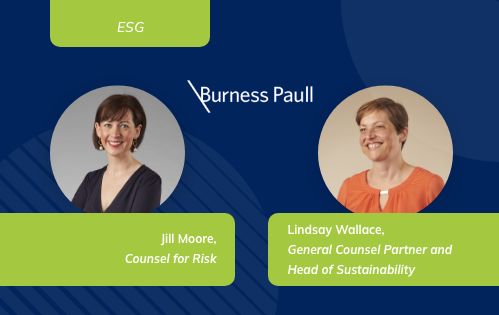Environment, social and governance (ESG) issues are preoccupying more and more of the time and brain space of senior management and general counsel.
So, it’s hardly surprising that the pressure to transition to more sustainable practices is also spilling over into law firms too.
In fact, Thomson Reuters estimates that 42% of the large firms in its client base now have dedicated ESG practices and 55% of law firms recognise they need to bolster their ESG capabilities and resources.
With many Clarilis clients now incorporating our technology into their ESG efforts, we asked independent Scottish firm Burness Paull to explain how document automation contributes to raising their performance across all three sustainability pillars.
“Like many law firms, we’re on a journey to improve our ESG impacts and the sustainability of our business,” says Lindsay Wallace, the firm’s GC partner and appointed Head of ESG.
“We know good governance is absolutely intrinsic to everything we’re doing to shape a culture that supports our sustainability strategy.
“We’re increasingly finding the digital platforms we use can have a significant value in helping us to deliver on our promises by embedding ESG into our work practices and behaviours.”
We continued this conversation with Jill Moore, Senior Counsel for Risk at Burness Paull. Here we share how automation impacts on each area of their sustainability strategy.
Environment – Cutting the print queue
For Burness Paull, developing an overarching ESG strategy has given them more transparency around the environmental impact of their operations.
“The sustainability umbrella has been very useful to pull everything together and actually to see where we could do better,” Jill explains. “We were doing things, but we weren’t fully recognising the environmental value of our actions or tracking what we were doing.”
Jill brings in document automation as a specific example of how the scrutiny that their ESG strategy provoked has heightened their awareness of the environmental impact of their work practices.
“The environmental value of reducing printing is massive,” Jill explains, going on to use their document heavy banking practice as an example.
“LMA documentation can run to more than 100 pages, and you could potentially be printing that out quite a few times to do a markup.
“With automation we’re no longer printing everything out and this is reducing our environmental impact. We didn't necessarily think of it in this way before.”
Social – Recalibrating our processes to encourage work-life balance
Wrapped up within the vast ‘social’ pillar of the Burness Paull ESG strategy, is a commitment to being a fair and supportive employer.
“When people are working exceptionally long hours – which they have been – as employers we have a responsibility to try and minimise the impact on wellbeing,” Jill says.
Working through a pandemic has thrown a whole new perspective on the need for work-life balance and raised awareness of the role technology could have in supporting colleagues to achieve this.
The experience of the pandemic has also emboldened lawyers to ask for investment in solutions that tackle the long-hours culture. For example, Jill mentions how technology is increasingly raised by candidates during the recruitment processes.
“Automation is something that people are now discussing at interview stage,” she says. “In terms of recruitment, it’s really important and it equally ties into retention as well.”
Governance – Making the drafting process watertight
Governance is something law firms are instinctively tuned into to.
The rise of ESG, amplifies the attention given to making sure internal processes are fair, transparent, and as watertight as they possibly can be.
Automation has a role to play in mitigating risk both for law firms and the clients they advise, especially in the case of complex matters and for clients operating in more tightly regulated industries.
“For example, keeping on top of the updates to LMA documentation is challenging, especially because we have to filter these changes through not just the documents that come from the LMA website but also through the versions of the document we’ve got on our system,” says Jill.
“There's plenty of room for error. With Clarilis, the integrity of the template makes sure what we're using is always as good as it possibly can be.
“This allows for more effective delegation and supervision and for senior lawyers to focus on the bigger legal issues, ensuring efficient output of the best quality.”
There is a higher purpose!
With major commitments being made in law firm boardrooms when it comes to ESG, firms are turning to technology, such as Clarilis, to drive forward change.
The success of these measures relies on lawyers adopting different ways of thinking – something that has been a barrier in the past.
Thankfully, times have changed. The impact of change is now reaching further than the law firm itself – it’s playing a part in global change for the industry, some might say for global benefit.
“The pandemic has broken down a lot of the most damaging barriers that were slowing down adoption of technology,” says Jill.
“If you told a corporate finance or banking lawyer two years ago that they wouldn’t have access to printer to print out all their documents all the time, they just wouldn’t believe that they could do their job in the same way.
“We now know that people adapt much better than everybody thinks they can.”
“We’re increasingly finding the digital platforms we use can have a significant value in helping us to deliver on our promises by embedding ESG into our work practices and behaviours.”
Lindsay Wallace
General Counsel Partner and Head of Sustainability, Burness Paull
"With Clarilis, the integrity of the template makes sure what we're using is always as good as it possibly can be."
Jill Moore
Counsel for Risk, Burness Paull


